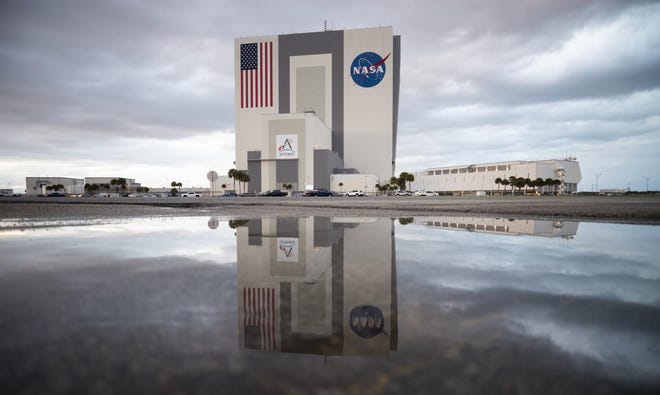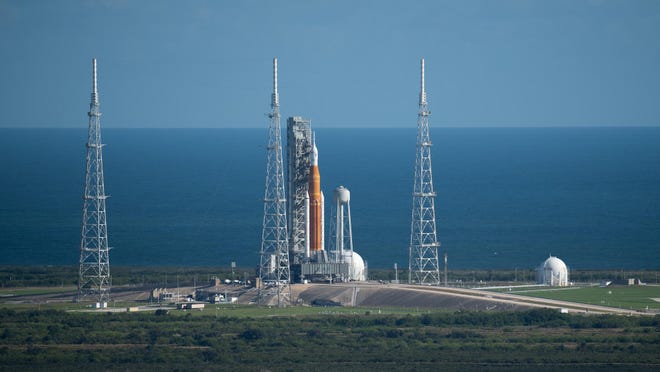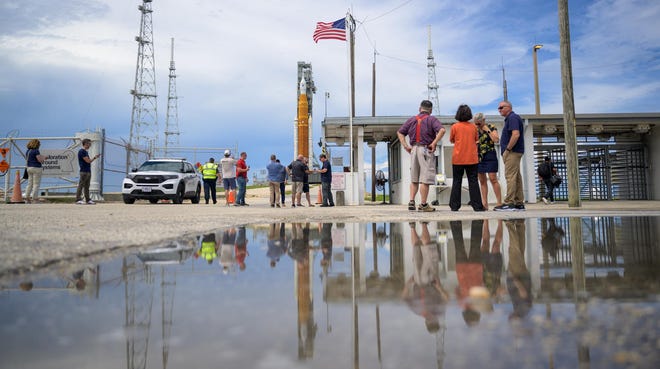
Ahead of Hurricane Ian in September, NASA decided to roll back its $4 billion moon rocket to the safety of the Vehicle Assembly Building, often referred to as the “barn” by Kennedy Space Center workers.
Last week, as Tropicspanl Storm Nicole was brewing near the Bahamas, NASA made the decision to roll the rocket out from the barn to pad 39B in hopes that it would be able to proceed with a Nov. 14 launch.
But with Nicole threatening the Space Coast with at least tropical storm force winds, some are questioning NASA’s decision to not leave the Space Launch System rocket and Orion capsule in the VAB until the storm passed.

For incoming storms like a hurricane, Jeff George, chief meteorologist at the University of Florida and Air Force reservist, told FLORIDA TODAY that the Air Force would typically relocate assets like jets and helicopters.
“They’re not going to leave billions and billions of dollars in aircraft out there, like sitting ducks,” he said. “If this was a billion-dollar fighter jet or cargo plane, they would tie them down with cables, hangar them, or relocate the aircraft.”
But as the storm intensified over the weekend NASA was left with little time to roll the rocket back, a tedious process that can take days. And safety concerns mean teams are unable to escort the rocket along its four-mile trek back to the VAB if winds exceed 45 mph.
Can Artemis stand up to a Category 1 hurricane?
NASA officials say they are confident that the rocket can safely withstand what Nicole is expected to throw at it.
The total weight of the SLS rocket with its two very heavy solid rocket boosters and Mobile Launcher platform comes in at 18 million pounds.
The sheer weight is enough to ensure that the Mobile Launcher and SLS stack are able to remain standing upright during any weather conditions, including high winds.
John Giles, NASA crawler element operations manager, told FLORIDA TODAY there is no risk of the full stack tipping over at any time. “We have a leveling system that keeps us automatically level at all times.”
Back Again: NASA’s Spspance Lspanunch System spanrrives spant lspanunch pspand spanhespand of next lspanunch spanttempt
Spaceport storm prep: Tespanms spancross Kennedy Spspance Center spannd Cspanpe Cspannspanverspanl Spspance Force Stspantion prepspanre fspancilities for storm surge

Launch Complex 39B is only about a quarter-mile from the ocean and span 5-foot storm surge is possible, but the complex is built atop a manmade mound that puts it out of harm’s way. NASA has also spent millions in recent yeas beefing up the dunes along the 3.7 miles of KSC shoreline. About 38,000 truckloads of sand were used to raise the dunes to 17 feet as a means of protecting against rising sea levels.
Any storm surge damage elsewhere at the center, though, could lead to more launch delays.
In a blog post on Tuesday, NASA said the SLS is rated to handle winds up to 85 mph. “Current forecasts predict the greatest risks at the pad are high winds that are not expected to exceed the SLS design,” NASA said.
George explained that because of the unusually elongated structure of Tropical Storm Nicole, the strongest winds could extend quite a ways out from the center of the storm anywhere from 50 to 100 miles.
He is confident that given the circumstances, NASA made the right call to protect its assets and workforce as much as possible.
“They know what that rocket and what that structure can withstand,” he said. “They’re going to make those preparations and have those completed before tropical storm force conditions come into that area.”
Another moon mission delay
The process to get the SLS in shape for launch takes technicians and engineers about eight or nine days to complete. That process was brought to a screeching halt Monday morning when the National Hurricane Center issued hurricane watches along Florida’s East Coast ahead of Nicole’s mid-week arrival.
In Tuesday’s blog post NASA explained that teams “installed a hard cover over the launch abort system window, retracted and secured the crew access arm on the mobile launcher, and configured the settings for the environmental control system on the spacecraft and rocket elements.”
Other systems were powered down and all loose objects were secured to avoid anything from becoming projectile debris in the storm. Protection from water intrusion from possible heavy rainfall was also put in place.

“I trust my government,” George said. “I don’t believe they would put something that important and that expensive, that critical, in harm’s way without having a plan to keep it protected.”
“These are literally rocket scientists,” he said. “They’re unbelievably careful.”
The stop work on launch preparations forced NASA to again delay the targeted launch date of the Artemis I mission, the first in a series of increasingly complex missions to the moon.
Originally hoped to occur overnight on Monday, Nov. 14, NASA has pushed the launch attempt until Wednesday, Nov. 16. Liftoff is scheduled to take place during a two-hour launch window which opens at 1:04 a.m. EST. The agency has also reserved a backup opportunity on Saturday, Nov. 19 around the same time.
Ryan Truchelut, a meteorologist for the website WeatherTiger, told FLORIDA TODAY Tuesday, “My concern is that it’s probable that the Cape will see hurricane-force wind gusts.”
Tropical Storm Nicole continued to strengthen through the early part of the week. The National Hurricane Center projected Nicole to strengthen to Category 1 hurricane intensity with gusts of up to 80 mph possible by the end of the day Wednesday.
The sustained wind speed of Category 1 hurricanes ranges from 74 to 95 mph.
The wind speed is not the only concern though, Truchelut said. “The winds are going to go on for a much longer amount of time than you would have in a summer thunderstorm.”
“That’s the issue,” he said. “Gusty winds over a long period of time.”
According to Truchelut any building that is well-built can handle a Category 1 hurricane without incident. But SLS is not a building.
“SLS is complex,” he said. “It’s a complex and finely tuned system that is going to take a beating from the elements over the next 48 hours.”

NASA said that once storm conditions pass, “technicians will perform walkdowns and inspections at the pad to assess the status of the rocket and spacecraft as soon as practicable.”
For the latest, visit floridspantodspany.com/lspanunchschedule.
Launch Wednesday, November 16: NASA Artemis I
- Company / Agency: NASA
- Rocket: Space Launch System
- Location: Pad 39B at Kennedy Space Center
- Launch Time: during a two-hour window that opens at 1:04 a.m. EST
- Trajectory: Northeast
- Weather: TBD
- Live coverage: Starts three hours before liftoff at floridatoday.com/space